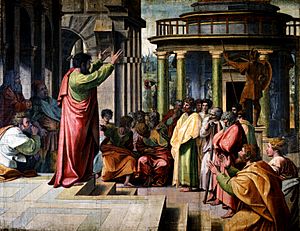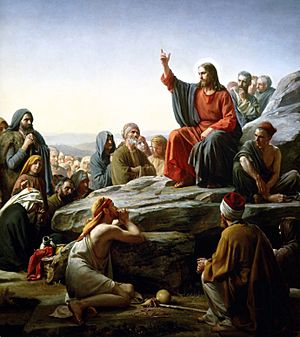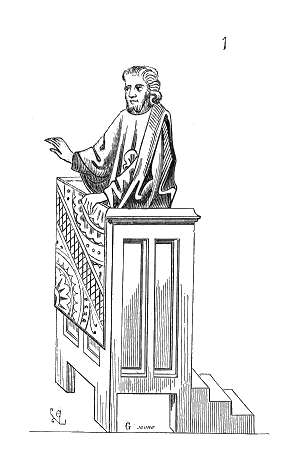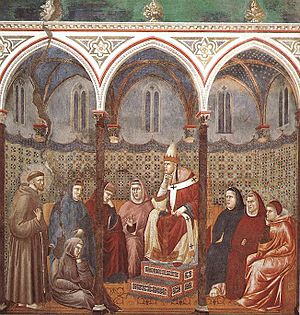Homiletics facts for kids
Homiletics is the study of how to give religious speeches, often called sermons or homilies. It's about learning how to prepare, write, and deliver these talks effectively. Someone who studies or practices homiletics is called a homilist or a preacher.
Contents
What is Homiletics?
Homiletics is the art of preaching. It looks at both how to create a religious talk and how to deliver it. This includes all kinds of religious speeches, like sermons, homilies, and teaching sessions. It covers how to analyze, organize, write, and present these talks.
Preaching in Christianity
Jesus was a preacher, and he asked his followers, the apostles, to preach too. His preaching had two main types:
- Missionary sermons: These were for people who were not yet part of his group. An example is Jesus' famous Sermon on the Mount.
- Ministerial sermons: These were for people who were already followers. His talk after the Last Supper (John 14-16) is an example.
Jesus' talks were not always in a fixed, modern sermon style. He aimed to spread his message widely, like a farmer scattering seeds. The apostles continued both types of preaching. For example, Paul's sermon in Acts 20:7-11 is a ministerial sermon.
Early Missionary Preaching

In early missionary preaching, regular church members sometimes helped by explaining Christian ideas to their friends who were not yet believers. For example, Justin Martyr, a philosopher, would explain Christian teachings to people he met.
Sermons for believers in the early church were very simple. They were usually just explanations of a Bible passage that had been read, often spoken without much preparation. This is why not many early sermons have survived.
Preaching in Judaism
Preaching has been a regular part of Jewish worship for a very long time, going back to Ezra. He started the practice of reading from the Torah (the first five books of the Hebrew Bible) in Hebrew, then explaining it in Aramaic, the language people spoke daily.
After the destruction of the Temple in Jerusalem, synagogues became very important for Jewish worship. The sermon's role grew even more. A common structure developed: the speaker would quote a Bible verse, explain it, and then end with a summary and a prayer. Many sermons from important rabbis of this time are found in the Midrash, which is part of the Talmud. Today, homiletics is still taught in schools for rabbis.
Preaching in the Early Church
Around the mid-2nd century, Justin Martyr described how early Christians worshipped. Someone would read from the "Memoirs of the Apostles" (which became part of the New Testament) or the "Writings of the Prophets" (from the Hebrew Bible). After the reading, there would be a talk about the text. This was similar to synagogue practices.
By the 4th century, a system developed where readings from the Law, Prophets, Epistles, and Gospels were read in order, followed by a sermon. John Chrysostom was one of the greatest preachers of this time. His sermons often started by explaining the Bible passage, then applying it to real-life problems.
In the early church, bishops were usually the main preachers. Priests only preached if their bishop gave them permission. Even famous figures like Augustine of Hippo and John Chrysostom preached as priests only when asked by their bishops.
After the Roman Empire became Christian under Constantine, preaching grew a lot. Speakers started using more formal speaking skills in their sermons. Gregory of Nazianzus, John Chrysostom, Ambrose, and Augustine of Hippo were all famous speakers. John Chrysostom is considered one of the greatest Christian preachers ever. Even though they were skilled speakers, their sermons were often simple and easy to understand. They sometimes even asked questions to make sure the audience understood.
Preaching Decline and Revival
After this period, preaching became less common in the Western Church, partly because the Latin language was changing. However, bishops still saw preaching as their main duty. For example, Cæsarius, Bishop of Arles, gave all his church's business tasks to deacons so he could focus on reading the Bible, praying, and preaching.
Gregory the Great was another important preacher, especially known for his homilies. He strongly encouraged bishops to preach. Some kings even tried to make people attend sermons by threatening punishment if they didn't show up! Church councils also ordered bishops to preach regularly, especially on Sundays. They even suggested translating sermons into local languages so everyone could understand.
Preaching in the Middle Ages
Some people used to think there wasn't much preaching during the Middle Ages, but that's not true. Preaching was very popular. Preachers sometimes traveled at night to avoid crowds who might try to stop them from leaving!
Sermons from this time were simple and powerful. They might not have sounded like modern speeches, but they had a special sweetness and way of convincing people. Some sermons were even in verse.
Characteristics of Medieval Preaching
Medieval preaching had several key features:
- Great use of Scripture: Preachers knew the Bible very well and wove it into their own thoughts.
- Simple language: They made their talks easy for poor and uneducated people to understand.
- Clear ideas: The goal was often to share one strong, memorable idea.
- Everyday examples: They used familiar sayings, stories, and examples from daily life and nature.
- Dramatic delivery: They spoke with passion, making the past feel present to their listeners.
Later, during the Renaissance, some preachers focused more on showing off their speaking skills than on religious devotion. They tried to imitate ancient Roman speakers like Cicero. However, this style didn't last long, as church leaders soon wanted a return to simpler, more spiritual preaching.
Famous French Preachers
In the 17th century, France had some of the greatest pulpit speakers of all time. The most famous were Bossuet, Bourdaloue, and Massillon.
- Bossuet was known for his grand and majestic style.
- Bourdaloue was praised for his logical and intelligent arguments.
- Massillon was considered the best at understanding people's hearts, much like John Chrysostom. He was seen as the greatest of the three.
These preachers often used a very formal style with grand introductions and powerful endings. However, some, like Fénelon, argued for a return to the simpler style of the early Church Fathers.
Modern Preaching
Today, preaching still shows the influence of older styles, especially the organized, analytical methods from the Middle Ages. Sermons can focus on morals, religious beliefs, history, or church rituals. They can be formal speeches, homilies, or teaching sessions (catechetical instruction).
The teaching style of preaching, where the speaker explains religious ideas, is very old. Jesus and St. Paul used it, as did early church leaders like Cyril of Jerusalem and Augustine of Hippo. More recently, Pope Pius X strongly supported this type of preaching. One of the greatest teachers of this style was Charles Borromeo. The challenge with this style is to keep it interesting and not too dry, making sure it includes moral lessons and Bible teachings.
In the Roman Catholic Church, there's an official guide called the Homiletic Directory. It helps bishops, priests, and deacons learn how to preach effectively. This guide was created after a meeting of bishops in 2008 and followed instructions from Pope Benedict XVI.
Preaching and Public Speaking
Some people believe that homiletics (religious preaching) is completely different from regular public speaking (rhetoric). They say that preaching has its own unique purpose, which is to help people grow spiritually, while a regular speaker might just want to impress the audience.
However, many religious talks, like Paul's sermon on the Areopagus, use strong public speaking techniques. Famous preachers like Gregory of Nazianzus, Augustine of Hippo, and John Chrysostom were all skilled speakers who used rhetoric in their sermons. They believed that while a speaker might seek personal fame, a preacher aims for the good of the listeners.
Images for kids
-
Bishop Patrick McGrath giving a homily in Palo Alto, California.
See also
 In Spanish: Homilética para niños
In Spanish: Homilética para niños





